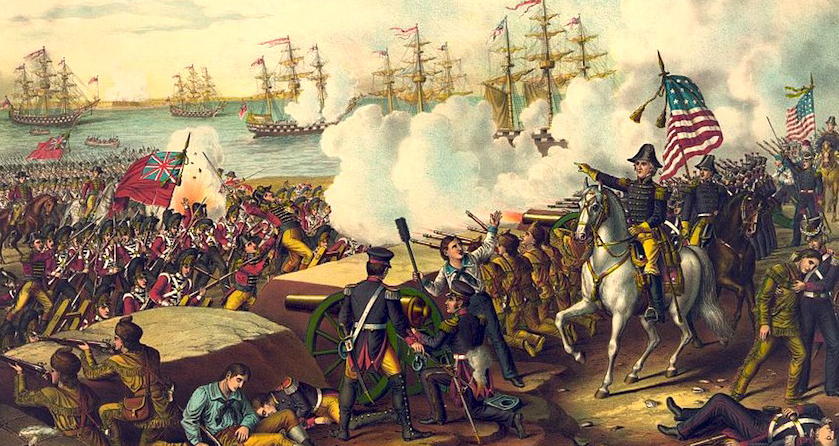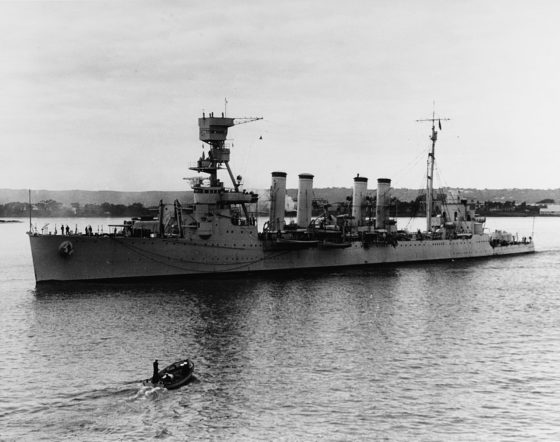
“Prior to the age of fast ships, telegraphs, radio or satellite communication, it could take days, weeks or even months for news of peace to reach an army in the field.”
TWO HUNDRED YEARS AGO THIS WEEK, the final battle of the War of 1812 was fought on the Chalmette Plantation about two miles east of the city of New Orleans.
In the pre-dawn darkness of Jan. 8, 1815, more than 10,000 British infantry moved north along the eastern bank of the Mississippi River right into a line of American fortifications. A force of 4,000 U.S. Army regulars and locals under the command of future president Andrew Jackson brought down a hail of rifle, musket and artillery fire onto the approaching redcoats with devastating effect. By the end of the morning, nearly 400 British soldiers lay dead and more than 1,500 were wounded. Another 500 were missing. It was the bloodiest battle of the conflict for the British. In fact, more redcoats died at New Orleans than had even fought in most other engagements of the war. American casualties by comparison were much lighter: 55 soldiers killed and 185 wounded.
The clash also stands out as one of the few engagements in the two-and-a-half-year-old conflict that the United States actually won. Up until that point, America’s conduct in the ground portion of the War of 1812 had been nothing short of farcical.
Yet, even more striking is the fact that the battle was fought more than two weeks after the United States and Great Britain had formally agreed to suspend all hostilities. For much of late 1814, diplomats from the estranged nations met at Ghent, Belgium to negotiate an end to the conflict. News of the peace treaty, which was signed on Christmas Eve, was in transit when the British and American troops met in Louisiana in early January. Upon learning that the war was in fact over, the British force and its supporting fleet of warships withdrew from the mouth of Mississippi and sailed for home.
Prior to the age of fast ships, telegraphs, radio or satellite communication, it could take days, weeks or even months for fresh orders or breaking news to reach an army in the field. And while the idea of militaries campaigning in such information vacuums seems hard to imagine in an era of instantaneous worldwide communications, in past centuries it was all just part of warfare. Not surprisingly, the British and American soldiers that killed one another on the banks of the Mississippi in early 1815 were not the only troops in history to fight on after the wars they were waging had already ended. There are a number of examples of similarly fruitless battles. Here are a few of them.

The Battle of Prague
Europe’s long and bloody religious feud known as the Thirty Years’ War finally ended when the Catholic powers of Spain and the Holy Roman Empire agreed to make peace with their Protestant enemies in 1648. The landmark Treaty of Westphalia not only ended a war that had already snuffed out eight million lives, it established many of the principles of the modern international system (but that’s another story). Unfortunately, details of the October peace agreement were entirely unknown to Prince Carl Gustaf, who at the time was leading three Swedish armies against Bohemian-held Prague. By that point, Gustaf’s forces had captured much of the city, but were unable to achieve total victory, thanks to a tenacious assortment of armed civilians who simply refused to capitulate. The battle, which began in June, was entering its sixth month when news of the treaty signed at Osnabruck had travelled the 600 kilometres to Gustaf’s army. Upon learning of the peace, the prince called off his troops, but not before they plundered Prague of a number of treasures. Much of this loot is still on display at the Swedish palace of Drottningholm. [1]

Blue vs. Grey after the White Flag
Even the newly invented telegraph couldn’t get news of the end of the American Civil War out to the extreme southern tip of Texas in time to prevent the last land battle of the bloody four-year conflict from taking place. The two-day clash at Palmito Ranch was fought on May 12 and 13, three days after the Confederacy formally surrendered. Ironically, the Civil War had all but ended in Texas several months before. While armies slugged it out elsewhere, an ad hoc armistice had been informally negotiated in early 1865 between the rebel commander James Slaughter and the Union general Lew Wallace (the future author of the book Ben Hur: A Tale of the Christ). Both officers realized the war would soon be over and were reluctant to squander the lives of their soldiers when peace seemed to be at hand. So what was it then that led a force of 500 U.S. Army troops and a company of veterans from Indiana into a clash with 300 Confederate cavalrymen at the mouth of the Rio Grande River ore than a month after Lee’s surrender at Appomattox? Some historians suggest that the officer commanding the Yankee troops near the Palmito Ranch, Colonel Theodore Barrett, hadn’t seen any action in the war and hoped to command troops in battle before it was too late.[2] Others hypothesize that Union officers wanted to seize Rebel goods stockpiled at the nearby town of Brownsville for themselves, or possibly even take Confederate cavalry horses to sell privately.[3] What is clear is that on May 12, Union troops moved against the Southern encampment in the area, which was situated on the banks of the Rio Grande — a stone’s throw away from a detachment of French Foreign Legion troops stationed on the Mexican side of the border. The Confederate troops promptly counterattacked. Both sides reinforced their infantry with artillery and for the next 24 hours, the two small armies had at one another. Barrett’s Yankees took the worst of it and withdrew late in the day on May 13, but not before 100 of his men were surrounded and captured by the Confederates — ironically, a southern triumph. Four Union troops died in the clash, 12 were injured. No Rebels were killed.

Don’t Give Up the Ship
While the Confederate victory at Palmito Ranch may have been the last land battle of the American Civil War, action would continue at sea for several weeks after the South’s final collapse. In fact, one Rebel commerce raider, the CSS Shenandoah, would go down in history for firing the final shot of the conflict. It did so while attacking Yankee whalers off the Aleutian Islands nearly two months after Richmond’s May 9 surrender. The Shenandoah, a converted British merchant clipper, had spent the previous nine months harassing Union shipping in the South Atlantic, Indian and Pacific oceans. After boarding a northern whaling vessel named The Susan & Abigail on June 27, 1865, the skipper of the Rebel warship, Captain James Waddell, was handed an issue of a San Francisco newspaper detailing the final hours of the war. While the story reported the surrender of the Confederate army at Appomattox two months earlier, the paper made no mention of the complete defeat of the South. Accordingly, Waddell continued to attack Union shipping – seizing 10 more whalers later that same day! It wasn’t until Aug. 2 when the Shenandoah encountered a British warship off the coast of California that the news of the war’s end was finally confirmed. Unwilling to turn the ship over to Union authorities and possibly face the hangman’s noose for piracy, Waddell set a course for Great Britain via Cape Horn. The Shenandoah put in at Liverpool on Nov. 6, 1865 completing a year-long circumnavigation of the globe that resulted in the capture or destruction of 38 Union ships. British authorities pressed no charges and set the Southerners free. Unable to return to the United States for fear of prosecution, many of the crew settled in South America. The Shenandoah herself was turned over to the United States. Washington soon sold the vessel to the sultan of Zanzibar.

Never Say Die
Just like the Shenandoah, hundreds of Japanese soldiers continued to fight on across the Pacific long after VJ Day. While some were unaware of the surrender in Tokyo Harbour, others simply refused to lay down their arms. American and Allied troops throughout the Pacific continued to clash with these holdouts for months, and even years after the war. A group of nearly 50 Japanese infantrymen waged a guerrilla war against American occupiers on Saipan until finally surrendering to Marines in December of 1945. More than 30 hid in the jungles of Peleliu until March of 1947 before they too turned themselves over to the Americas. Two Japanese troops stayed at their battle stations on Iwo Jima until January 1949, while nearly 20 remained at large on an island in the Marianas until June of 1951. For the next 20 years, small squads and even lone Japanese soldiers would emerge from the wilderness from time to time across the South Pacific and Southeast Asia. Lt. Hiroo Onada surrendered on Lubang in the Philippines not long after a Japanese backpacker stumbled across his basecamp in 1974. It still took personal orders from his then retired commanding officer before Onada finally agreed to call it quits. To read the full story and see a picture of his final surrender, click here. That same year, a Taiwanese-born private in the Japanese army was discovered and detained by authorities in the wilds of Indonesia. The last believed holdout was a captain by the name of Nakahara. Presumed to be hiding somewhere on the island of Mindoro in the Philippines, a Japanese-led rescue team set out to find the missing officer in 1980. The searchers stumbled upon what was believed to be his hut in April of that year. Nakahara himself was never found.
____________
If you’d like to receive alerts about the latest articles and posts, click on the link in the upper right margin marked “FOLLOW THIS BLOG”. And don’t forget to follow us on Twitter.
Originally published Jan, 11, 2013









